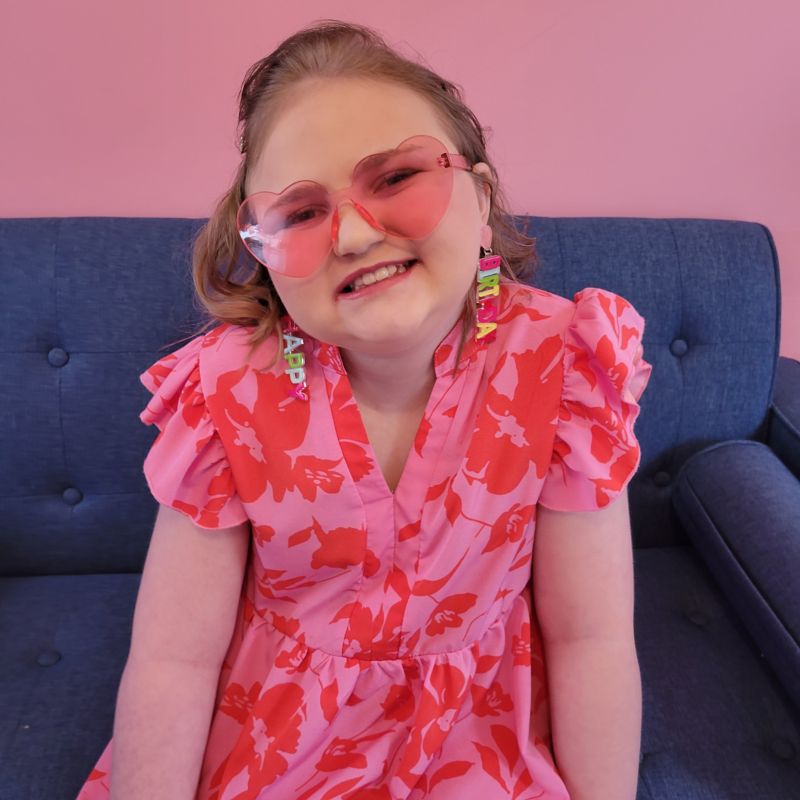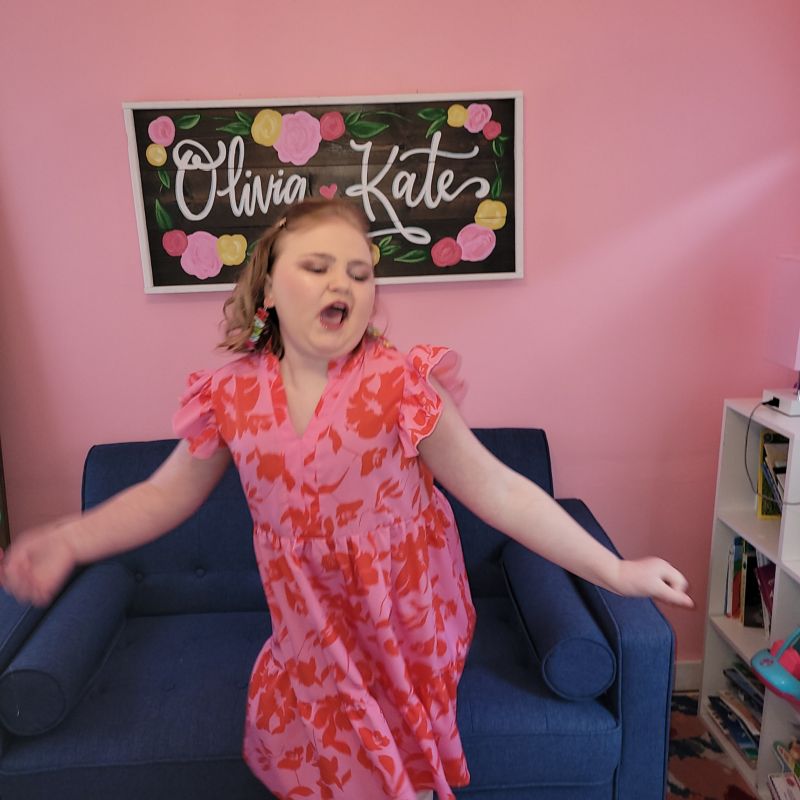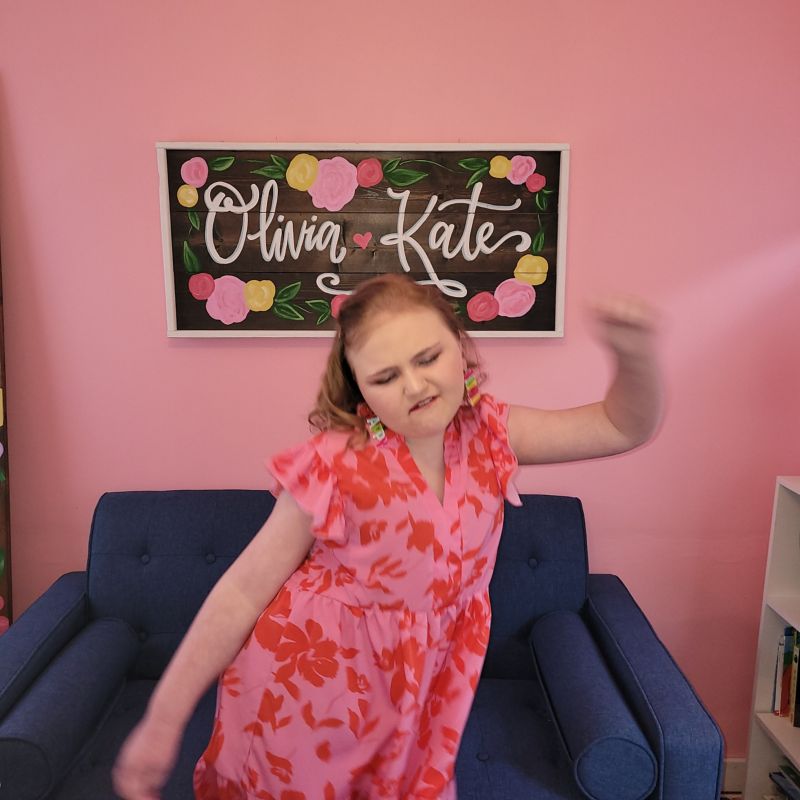St. Jude Family of Websites
Explore our cutting edge research, world-class patient care, career opportunities and more.
St. Jude Children's Research Hospital Home

- Fundraising
St. Jude Family of Websites
Explore our cutting edge research, world-class patient care, career opportunities and more.
St. Jude Children's Research Hospital Home

- Fundraising
‘It was the right time’: A bench-to-bedside journey for the targeted treatment of pediatric low-grade gliomas
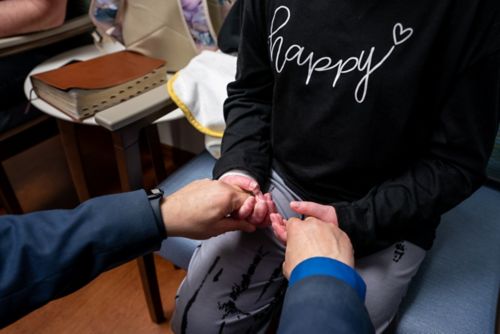
Olivia Thatcher grasps Ibrahim Qaddoumi’s, MD, hands during a recent checkup at St. Jude.
Thirteen-year-old Olivia Thatcher will proudly tell you she is ambidextrous. Born right-handed, Olivia now uses her left hand to do most things, a skill she taught herself as she navigated symptoms from the treatment of a growing brain tumor.
When she was diagnosed with a pilocytic astrocytoma in her brain stem at age 8 — a type of slow-growing brain tumor classified as a low-grade glioma — she does not recall much besides the excitement of riding in an ambulance. But she does recall the two years of chemotherapy that followed, administered monthly at a cancer center in Arkansas via an intravenous (IV) port implanted in her upper left chest.
When the brain tumor grew to the size of a lemon despite chemotherapy, and she began to lose strength on the right side of her body, she remembers coming to St. Jude. She remembers the six weeks she spent in Memphis receiving daily proton radiation treatments and fondly reminisces on the friends she made during her stay at the Ronald McDonald house.
In those six weeks, she also recalls how the tumor reacted to proton therapy in a response called pseudo-progression, where the tumor increases in size and shape before ultimately stabilizing. When the tumor had no room to expand further, Olivia remembers losing the ability to summon words at will, a condition called aphasia, and losing mobility on the right side of her body. Unable to hold her arm up, she stopped playing the flute in her middle school band. Frustrated with her right arm’s inability to form a melody on the keyboard, she also stopped taking piano lessons. She began using a wheelchair and spent the latter part of 2022 and much of 2023 either at home in Arkansas or at St. Jude.
Still, the tumor progressed. Despite the series of treatments that spanned from 2019 to 2022, imaging scans showed new metastatic growth in her brain stem and spine.
“It’s been a rollercoaster,” says Olivia’s parents, Amanda and Chris Thatcher.

Olivia and her parents, Amanda and Chris Thatcher, arrive at the St. Jude Brain Tumor Clinic.
When a tumor becomes a chronic condition
When Olivia was diagnosed in 2019, the Thatchers learned that pediatric low-grade gliomas (pLGGs) are the most common type of brain tumor in children and have a characteristically slow-growing nature. Because of these slow growth patterns, pLGGs are not considered as aggressive as other pediatric brain tumor types. But their location — frequently deeply embedded in the brain, surrounded by healthy brain tissue, nerves and blood vessels — makes complete surgical removal difficult.
For Olivia, attempting surgery was not an option because of where her tumor is in the brain stem. It was too great a risk.
When tumor removal is not possible, treatment approaches turn to long-term management, and the brain tumor and related symptoms become a chronic condition.
Ibrahim Qaddoumi, MD, MS, Department of Global Pediatric Medicine, Global Neuro-Oncology Program director and Olivia’s neuro-oncologist, explains that “pediatric low-grade gliomas are a chronic disease, and I make it clear to families that we will be dealing with it for many years. Think of it as hypertension or diabetes, where you may receive treatment for a long time.”
But what happens when the standard treatments, chemotherapy and radiation, fail to manage the tumor effectively, and it not only grows but spreads?

Ibrahim Qaddoumi, MD, greets Olivia Thatcher with a high-five in the St. Jude Brain Tumor Clinic.
“When they say metastasis, that’s a pretty hard spot. We had already done chemotherapy; we had already done proton radiation. We were losing options,” says Amanda.
Unbeknownst to the Thatchers, brain tumor research at St. Jude had been laying the groundwork for a targeted treatment that would soon give them another option.
The path to a targeted treatment for pediatric low-grade gliomas
Olivia had not yet been born when the molecular drivers of pLGGs were first discovered. In the mid-2000s, research showed abnormal activity in the mitogen-activated protein kinase (MAPK) signaling pathway — a vital cascade of molecular events and interactions responsible for healthy cellular function — as a trigger for low-grade glioma growth in children. The MAPK pathway is an active driver in about one-third of all cancers.
Overactivation of this signaling pathway is often triggered by abnormal activation of the gene BRAF, which causes normal cells to become tumors and grow in excess. Early treatments for pLGGs focused on BRAF inhibition to slow or stop the downstream overactivation of the MAPK signaling pathway.
However, continued analysis of pLGGs revealed abnormal BRAF activation to be more complex events than early experimentation showed. Studies demonstrated that BRAF activation in pLGGs involves the KIAA1549–BRAF gene fusion or an activating point mutation of BRAFV600E. While pLGGs containing the BRAFV600E point mutation responded well to BRAF inhibitors, there was concern that BRAF inhibitors further activated tumors containing the BRAF gene fusion. This concern, paired with the fact that most pLGGs contain gene fusions rather than activating point mutations, changed the therapeutic approach for these tumors.
In the 2010s, treatment options for pLGGs shifted to MEK inhibitors, a class of drugs that blocks MEK1 and MEK2 proteins as they act in conjunction with BRAF oncogenes to over-activate the MAPK signaling pathway. However, the success of these inhibitors may depend on their ability to overcome a major obstacle: the blood-brain barrier, a physical structure that acts as a protective sheath separating the brain from the rest of the body.
Qaddoumi emphasizes the difficulty the blood-brain barrier poses to therapeutic success. “Some of the drugs we give for low-grade glioma or other cancers, only a small fraction of the drug gets into the brain, which makes effective treatment difficult,” he says.
Early-phase clinical studies evaluated the effective dose and safety of various MEK inhibitors in the context of recurrent or treatment-resistant pLGGs. While those results were encouraging, scientists at St. Jude continued to examine these inhibitors’ ability to penetrate the blood-brain barrier.

Ibrahim Qaddoumi, MD, and members of Olivia Thatcher’s care team examine her skin during a recent checkup.
Overcoming the brain’s barrier to treatment
Suzanne Baker, PhD, Department of Developmental Neurobiology, co-leader of the Neurobiology & Brain Tumor Research Program, did not set out to make a discovery related to treating pLGGs.
She and her colleagues had spent years researching pediatric high-grade gliomas (pHGGs), a very aggressive class of pediatric brain tumors with a high mortality rate. Compared to pLGGs, pHGGs are more complex, driven by multiple genetic mutations and overactivation of several signaling pathways that spur tumor growth.
Baker’s laboratory research focused on the MAPK pathway. The goal was to map the complex array of genetic mutations driving pHGG tumor progression via MAPK pathway overactivation. With a growing genetic map, Baker’s team set out to evaluate treatments that target these mutations. Using models generated from brain tumor samples, Baker and colleagues performed high-throughput screening of several MEK inhibitors as potential treatment options to block MAPK signaling in pHGGs. The MEK inhibitors included developmental compounds and Food and Drug Administration (FDA)–approved agents used in therapies for adult gliomas.
As she continued to collect data about the performance of MEK inhibitors in pHGGs, she found their ability to penetrate the blood-brain barrier lacking. “These MEK inhibitors were being used in brain tumor clinical trials, but when we tested those in our models, I felt there was no point. They weren’t blocking signaling in the MEK/MAP pathway, possibly because not enough drug was getting in,” Baker says.

Suzanne Baker, PhD, discusses her research in pediatric brain tumors.
She presented the results to the multidisciplinary team in the Neurobiology & Brain Tumor Program at St. Jude, where a colleague listened to Baker’s results and suggested another MEK inhibitor to treat pHGGs, one the team had not been evaluating.
Burgess Freeman, PharmD, of the St. Jude Preclinical Pharmacokinetics Shared Resource, was familiar with MEK inhibitors, having studied their preclinical and clinical development as part of previous work in the pharmaceutical industry. He knew these inhibitors’ varied brain penetration capabilities and recalled the MEK inhibitor his colleague had recommended: mirdametinib. As a pharmacokineticist who measures how much of a drug gets into the tumor, Freeman was aware of this inhibitor’s potential best-in-class brain penetration capability.
Mirdametinib first appeared in studies evaluating pharmaceutical compounds for MAPK signaling pathway inhibition in 2005. But no one was considering mirdametinib’s potential to treat pediatric brain tumors. No one except St. Jude.
Taking a potential treatment from the bench to the bedside
Baker led research that assessed mirdametinib for treating pHGGs in laboratory settings and showed that mirdametinib was highly effective at blocking MAPK signaling, while other MEK inhibitors had minimal activity.
“We were looking at this from multiple levels and trying to combine mirdametinib with other drugs because, for high-grade gliomas, it is not enough to inhibit just the MAPK pathway. We need to hit more targets because of the complexity of those tumors,” Baker says.
Giles Robinson, MD, Department of Oncology, Division of Neuro-Oncology director and co-leader of the Neurobiology & Brain Tumor Program with Baker, saw potential from a different angle. Examining the data from Baker’s laboratory work, Robinson understood that mirdametinib would be a difficult drug to use as a treatment for pHGGs. But what about its potential for treating pLGGs?
“About 80 to 90% of pediatric low-grade glioma is driven by some mutation in the MAPK pathway,” says Robinson. Because taming overactivation of the MAPK pathway is the primary purpose of mirdametinib, perhaps the drug could succeed in these tumors. At least, this was Robinson’s thinking.
He met with Baker and Freeman who agreed it was time to move mirdametinib from the bench to the bedside. “By that point, we knew we shouldn’t be wasting time doing more in the lab. It was the right time to move this into the clinic,” says Baker.
Equipped with the research from Baker and the Neurobiology & Brain Tumor Program, Robinson met with a company to explain the findings from St. Jude that showed mirdametinib’s superior brain penetration over other MEK inhibitors.
They said, ‘write the trial or give us a concept, and we’ll review it.’ And that’s what started SJ901,” Robinson says.
SJ901: Another option for Olivia
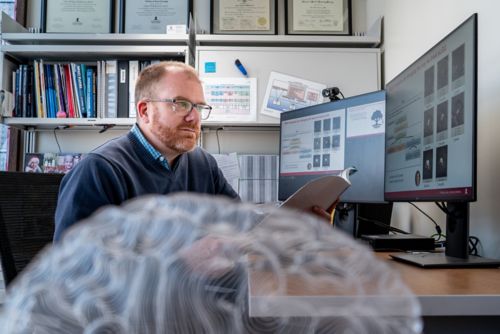
Giles Robinson, MD, examines results from a new treatment option for children with low-grade gliomas.
Robinson wrote the trial with Anna Vinitsky, MD, MS, during the 2020 pandemic. SJ901, the phase 1/2 clinical trial for recurrent or progressive pediatric low-grade gliomas, launched in June 2021 with Robinson and Vinitsky as co-principal investigators, just as Olivia was finishing her first two years of chemotherapy.
By the end of 2022, it was apparent her tumor was still growing. Olivia underwent surgery to collect a biopsy, which was analyzed using methylation profiling and RNA sequencing — next-generation genomic sequencing techniques that show a tumor’s genetic composition — to see if her tumor had any gene fusions driving MAPK pathway overactivation. It did. She qualified for treatment on SJ901.
But was Olivia up for yet another treatment?
She was hesitant. She remembered the experience of receiving chemotherapy through an IV port and the discomfort of wearing a face mask for proton radiation. But then she learned mirdametinib is administered in a pill.
“I said, ‘I’ll do it for the pill,’” Olivia recalls.
In August 2023, she enrolled in SJ901 and began treatment with the drug that targets her specific genetic mutation.
“To get a targeted drug? We’ve been waiting for this. We’ve been praying for this,” says Chris. After years of research, clinical trial planning, diagnoses and treatment hurdles, it was the right time.

Chris, Olivia and Amanda Thatcher pause for a moment on the St. Jude campus to share a moment of hope and gratitude.
Starting a targeted treatment: Phase 1 for SJ901 and Olivia
Olivia enrolled on SJ901 as part of phase 1, the portion of the clinical trial that evaluated the safety, tolerability and pharmacokinetics of mirdametinib administered by continuous dose —twice a day for two years — in patients with progressive or relapsed low-grade glioma.
For Olivia, this treatment is much different than her previous experiences with chemotherapy and proton radiation. “To me, it just feels normal,” she says.
For the first seven months of her targeted treatment, the Thatchers had to remind themselves that she was receiving treatment. There were hardly any symptoms except those of a shrinking tumor.
The tumor’s response to mirdametinib was positive. The metastatic growth slowly disappeared, and her tumor began to shrink.
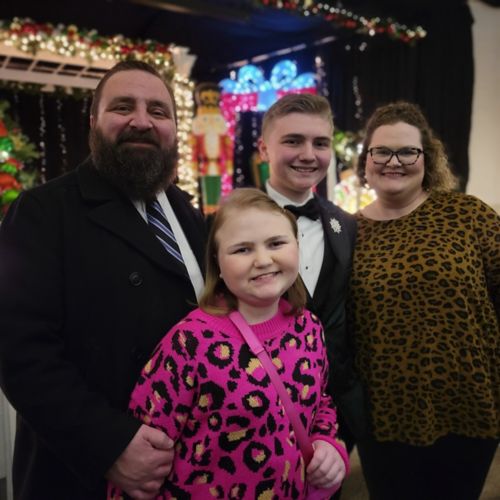
Chris, Olivia, Grayson (Olivia’s brother) and Amanda Thatcher pose for a family picture at Grayson’s tenth grade Winter Ball.
“The results were surprising. The first MRI of Olivia’s tumor, after one or two months of treatment, was impressive. I’ve never seen that kind of a response with a MEK inhibitor,” says Qaddoumi. “It was one of the best imaging results I’ve ever given to a family. Her parents were crying. The ability to give a family results like that makes this work worth it.”
As she continued treatment throughout the first few months, Olivia’s mobility began to return, assisted by weekly physical and occupational therapy sessions. About nine months into treatment, Olivia began to experience fatigue and a skin reaction that caused extreme dryness and flaking. Qaddoumi monitors her skin reaction when she visits St. Jude for her checkups, and the Thatchers stock up on moisturizers and try to minimize Olivia’s exposure to heat, which seems to spark flare-ups.
“Yes, we are on a research drug with some unknowns, but for the tumor to have a genetic match to what the drug targets has made the difference,” says Amanda. “It’s changing our lives; it’s changing us. It’s changing our outlook and Olivia’s future.”
“Her quality of life is there. It’s not declining,” says Chris.
-
Slide activated
-
Slide activated
-
Slide activated
-
Slide activated
Olivia Thatcher dances and celebrates her 13th birthday with all-pink decorations.
Phase 2 for SJ901 and Olivia
“This trial is all about quality of life,” says Robinson. “These MEK inhibitors, which are oral pills, allow kids to go back to school, function and live an everyday life. And they’re also much better drugs because they shrink the disease more than stabilize it. Mirdametinib is less invasive, less traumatic and more efficacious. It’s everything we would want to see.”
With the promising results of phase 1, SJ901 moved into phase 2 in October 2023. This phase of the trial measures the objective response rate and duration of response to mirdametinib. It now includes children with newly diagnosed low-grade gliomas as well as those with recurrent or progressive disease.
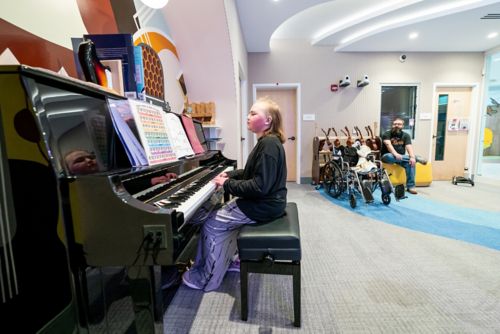

Olivia Thatcher plays piano in the Family Commons, cheered on by her father, during a recent visit to the St. Jude campus.
For Olivia, the improvements in her mobility allowed her to return to school. She is now in seventh grade and is the spirit keeper for her middle school cheerleading team. On the team, she makes signs and keeps the spirits of her team members high. Outside of school, Wednesday nights are a weekly highlight as she attends her church’s “Wednesday Night Live” program for youth, where church members gather to share in food and fellowship.
Her favorite thing to do that she was not able to do last year? Bowl.
Once a week, Olivia and her family, including her grandfather, whom she calls Papaw, go to their local bowling alley. With her Papaw by her side to give her tips, she gently guides her pink-and-white ball down the greased, wooden lane with her left hand. “I taught myself how to bowl left-handed!” she says.
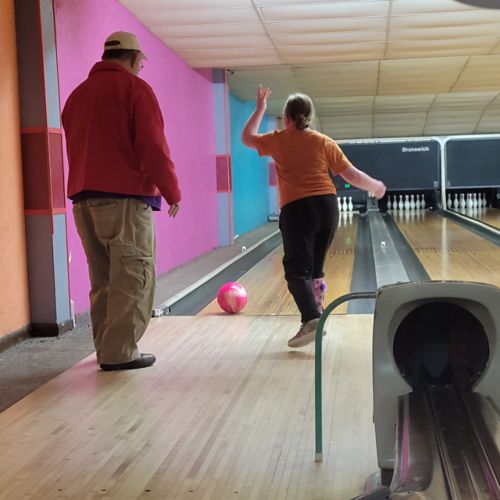
Standing next to her Papaw, Olivia Thatcher shows off her ability to bowl left-handed.
Over the past nine months, her progress has given the Thatchers a sense of security they have not experienced in quite some time.
SJ901 will continue to recruit children with low-grade gliomas with MAPK pathway activation (tumors with BRAF, MYB, MYBL1 fusions or rearrangements, FGFR1/2/3 alterations, NF1, PTPN11, SOS1, RAF1 mutations, etc.) or occur in a patient with known NF1, NF2, SOS1, RAF1 or PTPN11 germline mutation and evaluate their response to mirdametinib. The hope is to provide evidence that mirdametinib, with its brain-penetrant properties, is a good treatment option for pLGGs. These findings, if proven, would potentially make the targeted treatment accessible outside of clinical trials, which would give families faced with a chronic brain tumor another option.
“When you are on a stable drug regimen, and your tumor is shrinking, your life becomes more important than your tumor management. That’s what we hope for these children and their families,” says Robinson.
Olivia says it best when she describes what it feels like to live the life of a 13-year-old middle schooler who loves her family, God, bowling and coloring but who also takes daily treatment for a brain tumor, “It’s a miracle.”
